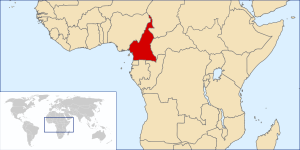A little background on Cameroon
 Time to zoom out a little, and look at Cameroon’s history. As observed earlier in this diary, the Germans beat the British in colonizing Cameroon. They swiftly took on the improvement of infrastructure, including the building of a railway – the one we used, from Ngaoundere, for instance -, but their use of forced labour didn’t make them all that popular. So few Cameroonians shed a tear, when Germany was forced out after the First World War, and most of the area was ‘awarded’ (this is how things went, at the time) by the League of Nations to France, with about 20%, bordering Nigeria, to Great Britain.
Time to zoom out a little, and look at Cameroon’s history. As observed earlier in this diary, the Germans beat the British in colonizing Cameroon. They swiftly took on the improvement of infrastructure, including the building of a railway – the one we used, from Ngaoundere, for instance -, but their use of forced labour didn’t make them all that popular. So few Cameroonians shed a tear, when Germany was forced out after the First World War, and most of the area was ‘awarded’ (this is how things went, at the time) by the League of Nations to France, with about 20%, bordering Nigeria, to Great Britain.
The Brits ruled their mandate from Nigeria, and largely neglected it, letting lots of Nigerians in, which caused resentment under the local inhabitants. The French did nominally better, incorporated their mandate into French Equatorial Africa, and established a commodities economy, based on cocoa, palm oil and timber. But during the first discussions about independence the colonial split became an issue, should the two Cameroons join, or should the British part link up with Nigeria? A bigger issue turned out the type of country Cameroon aspired to be, which led already before independence to a brutal civil war, with France violently suppressing the increasingly violent tactics of the opposition. In the end French Cameroon became an independent nation in 1960, to which the southern half of British Cameroon was added after a referendum in 1961 – which also decided that the northern half would join Nigeria. The first president was Ahmadou Ahidjo, from the north of the country, who, despite initial difficulties with ‘national reconciliation’ – continued fighting with unruly opponents, then managed to rule until 1982.
When Ahidjo stepped down, voluntarily, in favour of his groomed successor, Paul Biya, Cameroon was one of the few stable countries in the region, not in the least because of oil discoveries and associated revenues in the 1970. And although Biya initially proved less popular than expected – he survived a 1984 coup, and then dealt with the fall-out in that typically African way, executing all the dissidents – he is still the president, as we speak, last elected for a seventh term in 2018. This despite introducing multi-party system – and subsequently placing seven of the ten provinces under military rule, because the opposition proved too popular -, then rigging the 1992 elections, putting opponents under house arrest, closing independent news media and torturing journalists. But, you know, despite all this Cameroon was still far more stable than surrounding countries, so remained the darling of the West, even being admitted to the Commonwealth in 1995. Also in 1995, the first calls for independence of the former British Cameroon was voiced, and although this died down for a while, renewed claims were made in 2017, and tension between Anglophone and Francophone Cameroon remains. In the meantime, a border dispute with Nigeria, over an oil-rich peninsula was fought over, and settled in Cameroons favour in 2002, although some of the residents there would have preferred to be Nigerian. Oh, and in the north of the country the conflict between Nigeria and terrorist organisation Boko Haram is spilling over into Cameroon. No lack of challenges for the president, also because every dispute is standard met with violence and human rights abuse. Recurring theme, anyone?
Yet, despite all the above, Cameroon remains one of the stabler countries in the region, and richer in terms of GDP/capita than any of the other West African countries. And as long as we stay away from the north, and from the inevitable borders, it seems to be pretty safe, too. We will see!










